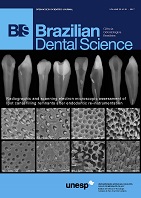Rosmarinus officinalis L. (rosemary) extract decreases the biofilms viability of oral health interest
DOI:
https://doi.org/10.14295/bds.2017.v20i1.1317Abstract
Objective: This study evaluated the effect of rosemary extract on Candida albicans, Staphylococcus aureus, Enterococcus faecalis, Streptococcus mutans and Pseudomonas aeruginosa monomicrobial biofilms viability, as well as on C. albicans associated with S. aureus, E. faecalis, S. mutans or P. aeruginosa in polymicrobial biofilms. Material and Methods: In microtiter plate, mono- and polymicrobial biofilms for 48 h were formed. Then, they were exposed for 5 min to rosemary extract (200 mg/mL). Saline (0.9% NaCl) was used as control. After, washes were done with saline to remove the affected cells. Biofilm viability was checked by MTT colorimetric assay, after treatment. Absorbance of the wells was read in microplate spectrophotometer (570 nm) and data were converted to reduction percentage and statistically analyzed by ANOVA and Tukey test (p ? 0.05). Results: After application of rosemary extract, with exception of the E. faecalis biofilm, significant reductions in mono- and polymicrobial biofilms viability were observed. Conclusion: C. albicans, S. aureus, S. mutans and P. aeruginosa monomicrobial biofilms were affected by rosemary extract, as well as C. albicans associated with S. aureus, E. faecalis, S. mutans or P. aeruginosa in polymicrobial biofilms, presenting significant viability reductions.
Downloads
Downloads
Published
How to Cite
Issue
Section
License
Brazilian Dental Science uses the Creative Commons (CC-BY 4.0) license, thus preserving the integrity of articles in an open access environment. The journal allows the author to retain publishing rights without restrictions.
=================




























